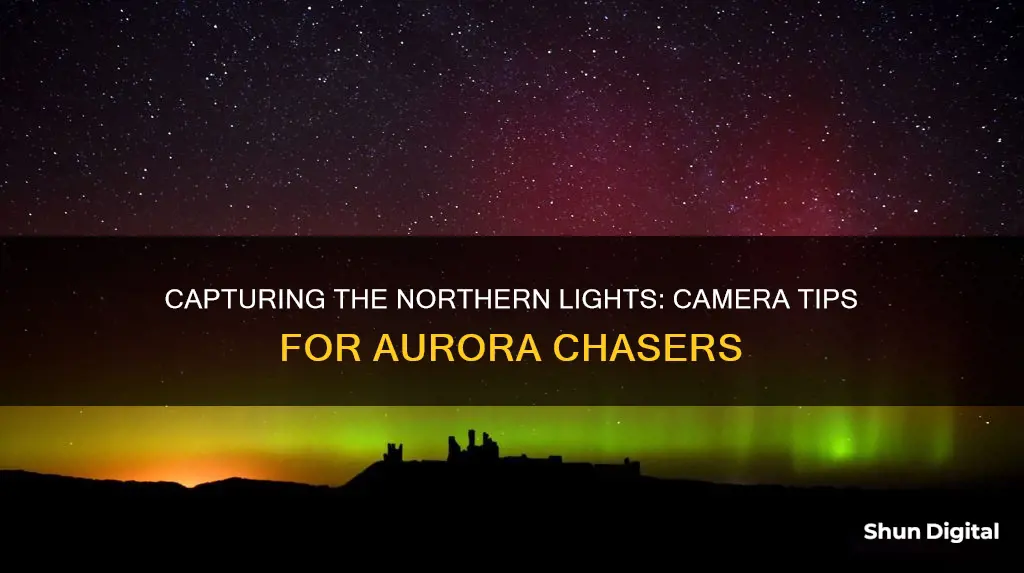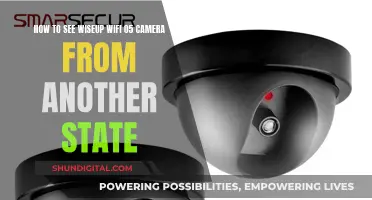
Capturing the aurora borealis, or Northern Lights, with a camera is a challenging but rewarding endeavour. The Northern Lights are a spectacular natural light show, visible at certain times of the year in northern parts of the world, such as Norway, Finland, Sweden and Iceland. To photograph this phenomenon, it's recommended to use a camera with manual settings and a wide-angle lens. A DSLR or mirrorless camera is ideal, but it is possible to capture the lights with a smartphone camera. The key camera settings to adjust are the focus, shutter speed, ISO and aperture. It's also important to find a location away from light pollution and to stabilise the camera, for example, by using a tripod. With the right equipment, settings and conditions, photographers can capture stunning images of the Northern Lights.
What You'll Learn

Camera settings for aurora borealis photography
Capturing the beauty of the Aurora Borealis requires a good eye and a good camera. Here are some camera settings to help you capture stunning photographs of the Northern Lights.
Firstly, it is recommended to use a DSLR or mirrorless camera that can handle high ISO settings up to 6400 without becoming overly grainy. A wide-angle lens between 12 to 24mm (full-frame equivalent) with an aperture between f/1.4 to f/2.8 is ideal.
Now, let's get into the specific settings:
- Manual Mode: Set your camera to manual mode. While modern cameras have great automatic modes, manual settings give you more control over the final image.
- Focus: Set your focus to infinity, especially if you are shooting at night. It is best to set the focus during the day and mark the correct lens position to avoid fumbling in the dark.
- Aperture: Use a wide aperture by opening your camera's aperture as wide as it will go (the lowest possible f-stop). This ensures that the Northern Lights and the sky are in focus, rather than the surrounding environment. An aperture between f/2.8 and f/4 is recommended, with some sources suggesting even lower f-stop numbers.
- Shutter Speed: Use a low shutter speed, depending on the speed and brightness of the Aurora. A faster-moving Aurora requires a shorter exposure time to capture its colour and detail. Shutter speeds can range from 4 to 30 seconds, with 10-25 seconds being the most common range.
- ISO: Set a high ISO value to compensate for the low-light conditions. Values between 800-6400 are recommended, depending on the brightness of the Aurora.
- White Balance: Experiment with different white balance settings. Try setting your white balance to automatic and take a test shot. If you are not satisfied with the result, you can manually adjust it to a Kelvin value of around 3000-5000.
- RAW Format: Consider shooting in RAW format to get the best results. This uncompressed format gives you more flexibility in post-processing, allowing you to adjust the light and colour more easily.
Remember to familiarise yourself with your camera settings before heading out to photograph the Aurora Borealis. Practice different techniques, and don't be afraid to experiment to find the perfect settings for your equipment and conditions.
Can the FBI Spy on You Through Your Camera?
You may want to see also

Best equipment for aurora borealis photography
Capturing the perfect image of the Aurora Borealis is a challenging task, but with the right equipment, you can drastically increase your chances of success. Here is a list of the best gear to photograph the Northern Lights:
Camera
The best camera for you is the one you already own. However, if you are looking to invest in a new one, there are a few features you should consider. Firstly, your camera should have manual mode, allowing you to control the f-stop, shutter speed, and ISO manually. It is also recommended to use a full-frame camera, as it will produce higher-quality images with less noise than a crop sensor camera. Examples of suitable cameras include the Canon EOS Ra, Nikon D810A, and Sony A7III.
Lens
For photographing the Aurora, you will want to use a wide-angle 'fast' lens. Wide-angle lenses allow you to capture a broader view of the sky and landscape, while fast lenses have a high aperture, allowing more light to reach the sensor. A minimum aperture of f/2.8 is recommended, with some sources suggesting a range of f/1.4 to f/2.8. Prime lenses tend to be faster and lighter, but zoom lenses offer more versatility. Some specific lenses that are well-suited for Aurora photography include the SIGMA 14mm F1.8 DG HSM ART and the Samyang XP 14mm F2.4.
Tripod
A tripod is essential for keeping your camera steady during the long exposures required for Northern Lights photography. It should be sturdy enough to support the weight of your camera equipment. Carbon fibre tripods, such as the Manfrotto BeFree Carbon Fibre Travel Tripod, are ideal as they reduce vibration and provide sharper images.
Other Accessories
While not mandatory, other accessories can enhance your Aurora photography experience. These include an intervalometer, a shutter release, photography gloves for cold weather, and noise reduction software for post-processing.
Mastering Camera View in Blender: See What Your Camera Sees
You may want to see also

Best locations for aurora borealis photography
The Northern Lights, or the aurora borealis, are a spectacular natural light show visible from some of the world's northernmost latitudes. The lights are caused by solar flares, and their appearance is affected by the Earth's magnetic field. The lights are notoriously elusive, but with some planning, the right equipment, and a bit of luck, you can capture stunning photographs of this phenomenon.
Norway
Norway is one of the best places to see the Northern Lights due to its proximity to the north magnetic pole and low light pollution. The northern parts of the country, such as Tromsø and Kirkenes, offer excellent viewing opportunities. The Lofoten archipelago is also a popular choice for photographers, as it provides dramatic foregrounds with its mountains and fjords. When sailing along the Norwegian coast, you can get away from light pollution and capture the lights reflecting on the water. Just remember that shooting from a moving ship can be challenging due to the motion of the waves.
Iceland
Iceland has become a very popular destination for aurora chasers in recent years. The country offers a great circular road network, regular flights, and breathtaking landscapes, including geothermal pools and husky sledding opportunities. The Jökulsárlón Glacier Lagoon is a particularly good spot to witness active, bright displays of the Northern Lights. If you want to avoid light pollution, consider booking a night tour away from the city lights of Reykjavík. The Snaefellsnes Peninsula and the south coast, where you can find Hotel Rangá, are also great options.
Finland
The north of Finland, including the town of Rovaniemi, is another excellent location for aurora photography. Here, you can cross the Arctic Circle and witness the aurora as early as 3 pm during the polar night. If you go even further north, you'll reach the town of Inari, which offers a unique setting with its sparse population, frozen lake, and Saami culture. Just be prepared for extremely low temperatures, which can reach -40 degrees Fahrenheit.
Canada
Canada, specifically the province of Alberta, is a prime location for viewing the Northern Lights. Alberta is home to several dark sky preserves, such as Jasper National Park, where you can find dark, unspoiled skies and a variety of wildlife.
Other locations
While less common, it is possible to see the Northern Lights from the UK, New Zealand, and Tasmania during strong geomagnetic storms. However, you will need to time it right, find dark locations, and be prepared for icy conditions.
Trail Cameras: How Far Can They See?
You may want to see also

Tips for aurora borealis photography
Capturing the beauty of the Aurora Borealis (or Northern Lights) is a challenging but rewarding endeavour. Here are some tips to help you get started:
Equipment:
- A DSLR or mirrorless camera is recommended for high-quality images.
- Use a wide-angle lens (12-24mm or 14-30mm full-frame equivalent) with an aperture between f/1.4 to f/4.
- Bring a sturdy tripod to stabilise your camera and minimise vibrations, especially when shooting from a moving ship or in windy conditions.
- Carry extra batteries, as cold weather can drain them quickly.
Location and Timing:
- Find dark skies away from light pollution. Use tools like the Blue Marble Light Pollution Map to identify areas free of light pollution.
- Aim for clear skies with low cloud cover (0-30%). Check local weather forecasts to increase your chances of clear skies.
- The best time to capture the Aurora Borealis is generally from autumn until spring.
- Use Aurora forecast apps and the KP index to predict the likelihood of Aurora activity. A higher KP value indicates a greater chance of seeing the Aurora at lower latitudes.
Camera Settings:
- Use manual mode on your camera to have full control over the settings. Familiarise yourself with these settings before your shoot, so you're not fumbling in the dark.
- Set your focus to infinity, preferably during daylight hours, to ensure sharp images.
- Use a wide aperture (lowest possible f-stop) to keep the Aurora and the sky in focus while blurring the surrounding environment.
- Select a low shutter speed (up to 30 seconds) depending on the speed and brightness of the Aurora. Faster-moving Auroras require shorter exposure times.
- Set a high ISO value (800-6400) to capture enough light. Higher ISO values result in grainier images, so adjust accordingly.
- Experiment with different white balance settings. Try the automatic setting first, and if the results are unsatisfactory, switch to a manual Kelvin value of around 3000-5000.
Composition and Etiquette:
- Include interesting foreground elements in your composition, such as mountains, fjords, or unique subjects.
- Practice good aurora-viewing etiquette by using a red torch to navigate in the dark, as red light preserves your night vision and is less intrusive to others.
- Remember to put down the camera and simply enjoy the spectacle with your own eyes!
LG Smart TVs: Built-In Cameras or Not?
You may want to see also

Smartphone photography of aurora borealis
Location
Firstly, you'll need to find a good spot with low light pollution and a clear sky. Light pollution is caused by street and city lights, so to get a better view of the Northern Lights, you'll need to find a dark place away from cities. There are many light pollution maps available online to help you choose a location.
Equipment
You will, of course, need a smartphone. If your phone has a "Night Mode" feature, that should be good enough to capture the aurora. The following smartphones have been known to produce excellent captures:
- Google Pixel 6
- IPhone 13
- Samsung Galaxy S22
- Samsung Galaxy S21
- IPhone 12
- Google Pixel 5
- IPhone 11
You may also want to invest in a tripod and phone holder to keep your phone steady and prevent camera shake. If you don't have a tripod, you can try to find a flat surface, like rocks or branches, to prop up your phone.
Settings
Use your primary lens, not a super-wide lens, and set your phone to manual mode if possible. A lower ƒ value will allow more light to pass through the lens, so aim for an ƒ-stop of 2.8 or lower. A higher ISO value will also help with light sensitivity; start at 1600 and adjust as needed.
Technique
Try to find a point of focus in the distance, such as a star, to ensure your image is crisp. If you're including the foreground in your image, try to find trees, a building, or another object to give the viewer context and perspective.
Taking a long-exposure photo will help you capture the colours of the aurora, even if they're too faint for your eyes to see. Experiment with different shutter speeds, starting at around 10 seconds, and adjust according to the speed and brightness of the lights.
Post-Processing
While it's best to avoid oversaturating colours during editing, you can enhance your images by adjusting the light and colour or changing the temperature to create a different atmosphere.
The Evolution of Broadcast TV Cameras: Why So Large?
You may want to see also
Frequently asked questions
A DSLR or mirrorless camera is best for capturing high-quality images of the Aurora Borealis.
Use manual mode on your camera and manual focus. Set your focus to infinity and use a wide aperture. Select a low shutter speed and a high ISO value.
Use night mode on your phone to capture photos of the Aurora Borealis. If you have an iPhone, shoot your photos in RAW format if possible, and turn off your flash. Use a tripod to keep your phone steady and adjust the exposure time in the hidden menu.
Go north and shoot towards the north. Stay away from city lights and light pollution. Consider travelling to Finnish Lapland, Swedish Lapland, Iceland, Svalbard, or Northern Norway.
The best time to see the Aurora Borealis is from autumn until spring, preferably on a clear night.







